Adolf Hitler’s first visit to the Kehlsteinhaus would take place on 16th September 1938, some seven months before it was officially presented to him for his fiftieth birthday in April 1939. The Nazi leader, probably much to Martin Bormann’s disappointment, would only make fourteen trips up to the house between his first visit and October 1940: he had long made clear his aversion to heights and the rarefied air at the top of the mountain, and had continually expressed his reservations over the safety of the elevator and the risk of bad weather.
Perhaps Hitler’s biggest fear was of the elevator winch mechanism on the roof attracting a lightning strike, and as much as he thought the house presented a wonderful opportunity to entertain important and impressionable guests he more often than not left the entertaining duties to others. His fear about lightning hitting the house was not without foundation, and Bormann would take great pains to avoiding mentioning the two serious strikes that had taken place during construction. Of course, had Hitler even got wind of these incidents, the Kehlsteinhaus might very well have turned out to be the most expensive and useless birthday present ever.
October 1938 saw Hitler make a number of trips to the Kehlsteinhaus in what was a very short period: between the 16th and 24th, he visited on no fewer than half a dozen occasions. In all, thirteen of his fourteen documented visits were made before the start of the war in September 1939. Visitors would include important domestic political figures such as the Reichsführer-SS Heinrich Himmler, Deutsche Arbeitsfront (German Labour Front) head Dr. Robert Ley and propaganda minister Joseph Goebbels, while from overseas the likes of Italian foreign minister Count Gian Galeazzo Ciano and French ambassador André François-Poncet were suitably impressed.
Having made the journey up to summit in August 1939 – just weeks before the declaration of war – the Führer would wait over a year before his making his final visit on 17th October 1940 when he played host to crown princess Marie-José, sister of Belgian King Leopold III. ![]()
![]() Did You Know?Princess Marie-José, who married Prince Umberto of Italy in 1930, would become Queen of Italy for a month following the abdication of King Victor Emmanuel III.
Did You Know?Princess Marie-José, who married Prince Umberto of Italy in 1930, would become Queen of Italy for a month following the abdication of King Victor Emmanuel III.
Hitler’s infrequent visits to the Kehlsteinhaus were also very short: he tended to spend just a few hours at the summit, usually departing well before the evening. Not one dish for the Führer would ever be cooked in the specially-fitted kitchen, while the study specially created for the Nazi leader was never used. Meanwhile, the attractive house on the mountain would turn into a popular destination for others in the Nazi leader’s inner circle, with one of the more frequent visitors being his mistress Eva Braun.
In spite of the fact that he chose not to visit the Kehlsteinhaus on a regular basis, Hitler would actually have a degree of input with regard to the basic layout and furnishing of some of the rooms – which were illustrated in a number of “storyboard” watercolours. These pieces captured the essential spirit of the house and its interior design, which was both relaxed and informal – the perfect opportunity to remove oneself from the violent conflict raging outside.
Many of the ideas on the decor and furnishing in these watercolours took their cues from the Mooslahnerkopf Teehaus, which Hitler often used to escape from his role as leader and warlord: this was of course the idea that had motivated and driven Bormann’s commissioning of the Kehlstein project in the first place.
It is difficult to avoid painting a more ordinary picture of the Nazi leader, but it is well known that he liked nothing better than to get away from it all by relaxing with those willing to endure his monologues accompanied by a plate of sweet cakes and a pot of hot tea. Unfortunately for Bormann, he was not to know that the Führer’s love of tea, cakes and agreeable company wouldn’t extend to taking regular trips up a brass elevator to a mountain summit.
Most Frequent Visitor: Eva Braun
While Hitler was not massively keen on visiting his mountain eyrie, it proved to be very popular with other members of his inner circle and the “Obersalzberg set”. Among the most frequent visitors were his mistress and eventual wife Eva Braun, who continued to made the journey to the summit with friends and relatives well into the 1940s. Eva would often visit with Bormann and his family, and she was also close to house administrator Gretl Mitlstrasser, who had been her one-time personal maid at the Berghof.
Video footage can be seen of Eva at the house – usually with other Nazi leaders, her sister Margarete (“Gretl”) or best friend Marion Schönmann – and she often took walks with her dogs along the mountain paths before retreating to her favourite room, the Scharitzstube. Her association with the room has as a result often led to it being called the “Eva Braun Zimmer” or “Eva Braun Room”.
The Kehlsteinhaus was such a popular venue for the Braun family, that it was selected as the venue for the reception party following the wedding of Eva’s younger sister Gretl to SS-Gruppenführer Hermann Fegelein on 3rd June 1944. Numerous photographs exist of the happy couple and their guests celebrating in the main reception hall, but true to form Hitler would not be present, having left after attending the ceremony in nearby Salzburg.
Bormann would continually use Eva’s love of the Kehlsteinhaus to try and encourage Hitler to make further visits, but even this was not convincing enough to make the Führer make his way back up to the summit.
While Hitler was more than happy to remain in residence at the Berghof and continue with his frequent walks to the Mooslahnerkopf Teehaus further down the mountain, Eva continued to take almost every opportunity to visit the Kehlsteinhaus until the summer of 1944 when Bormann finally found himself having to give in to having anti-aircraft artillery units stationed on the mountain. With the war having made its way to the peak and the summit now crawling with military personnel, much of its appeal as a quiet place of solitude was lost.
Eva’s carefree mountaintop jaunts would finally come to an end in July 1944, when Hitler and his entourage departed this small corner of the Berchtesgadener Land for the final time. Following the Normandy landings the Allies were rapidly advancing towards Germany, and the writing was soon on the wall for the beleaguered Nazi leader and his regime.
As for the Kehlsteinhaus itself, it would survive the massive bombing raid by the Royal Air Force that took place just days before Hitler’s suicide in Berlin in April 1945: while much of the Obersalzberg complex had suffered serious structural damage, the house at the top of the mountain proved to be a more elusive target.
Had the Kehlsteinhaus been half as popular with Hitler as it had been for Eva Braun and some of the regime’s lesser lights, one could argue that it might not even be there today. While Bormann’s creation remained standing and was slowly transformed into one of the popular tourist destinations in the region after the war, all of the other Nazi-era buildings elsewhere on the Obersalzberg – including both the Berghof and the Mooslahnerkopf Teehaus – were completely destroyed and subsequently erased from the landscape.
Those who have been able to take the bus ride up the mountain road and visit the Kehlsteinhaus should perhaps be thankful for Hitler’s fear of heights, aversion to the thin mountain air and his irrational sense of paranoia concerning the elevator – an outstanding piece of machinery that has not failed on one single occasion since its installation seventy-five years ago.


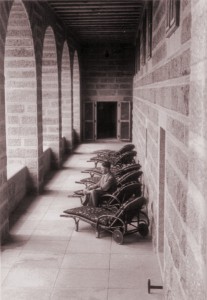
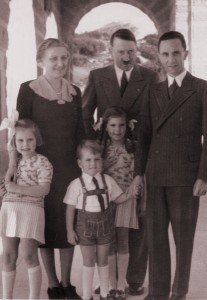
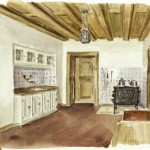
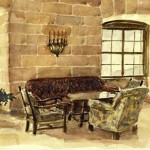
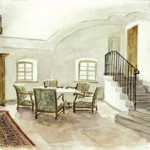
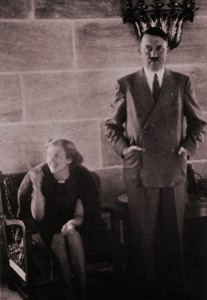
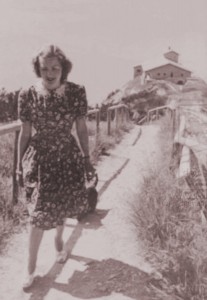
Pingback: Hiking to the Eagle's Nest in Berchtesgaden, Germany | Countdown to Friday
Pingback: Kehlsteinshaus och att besöka Örnnästet | FlyingDryden